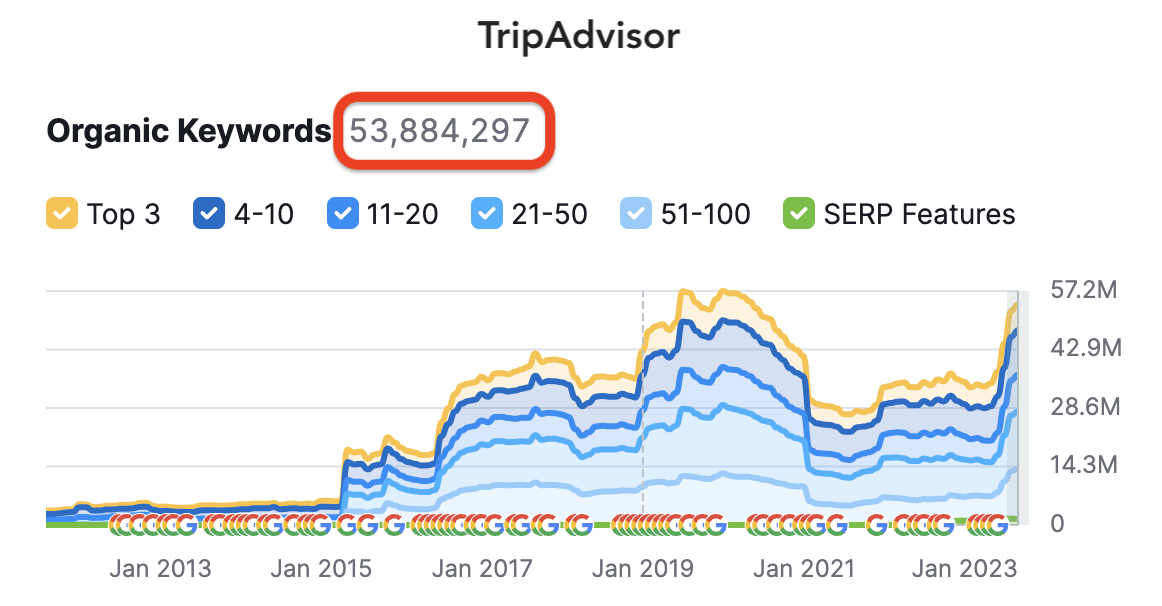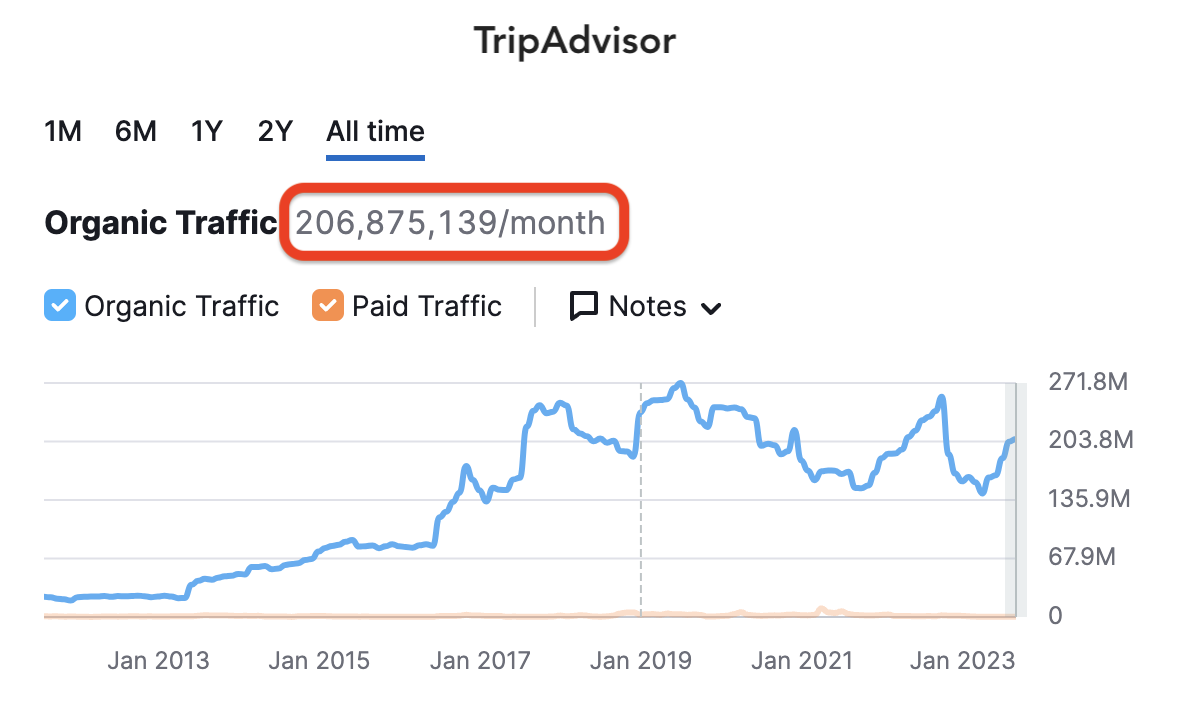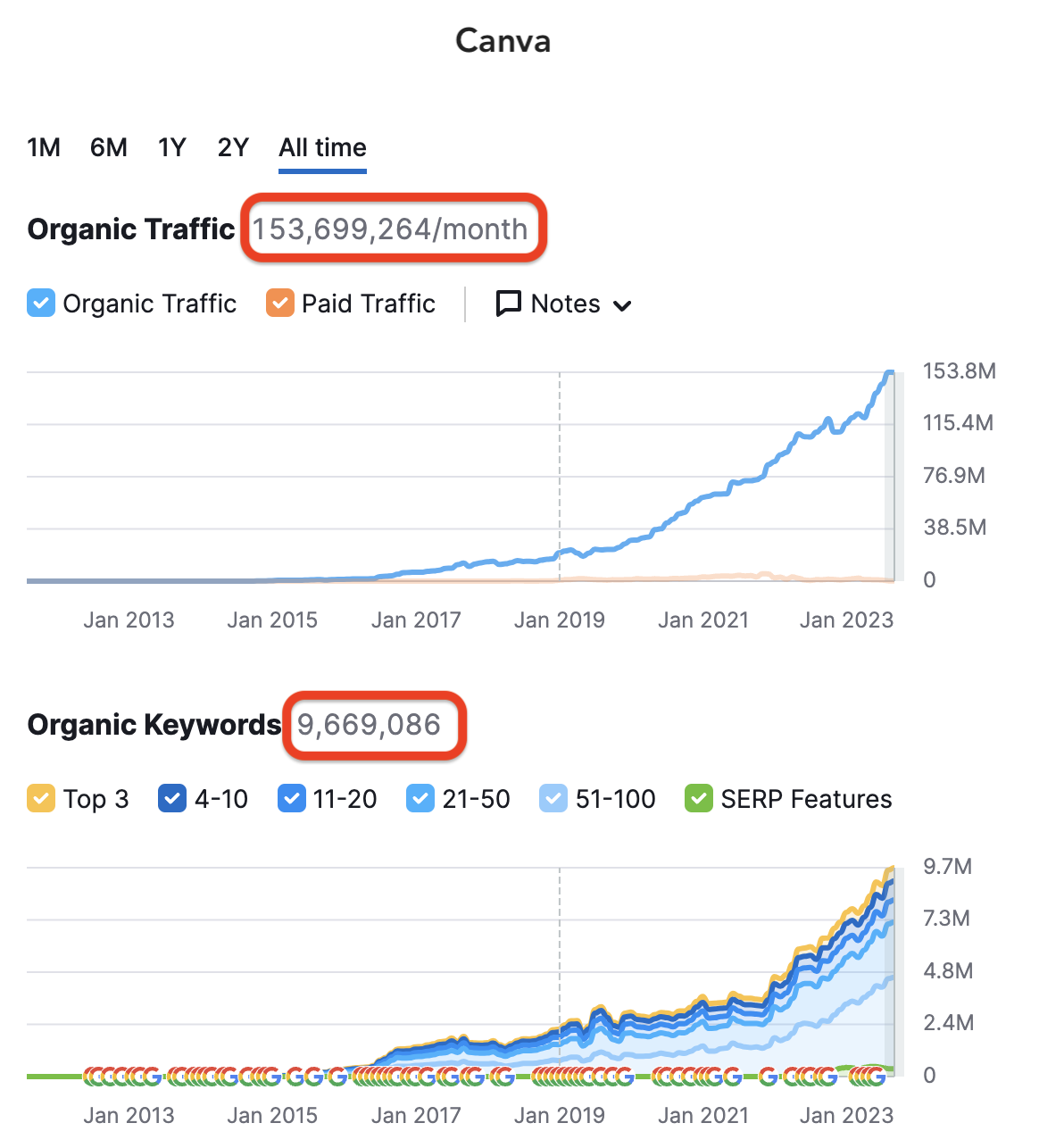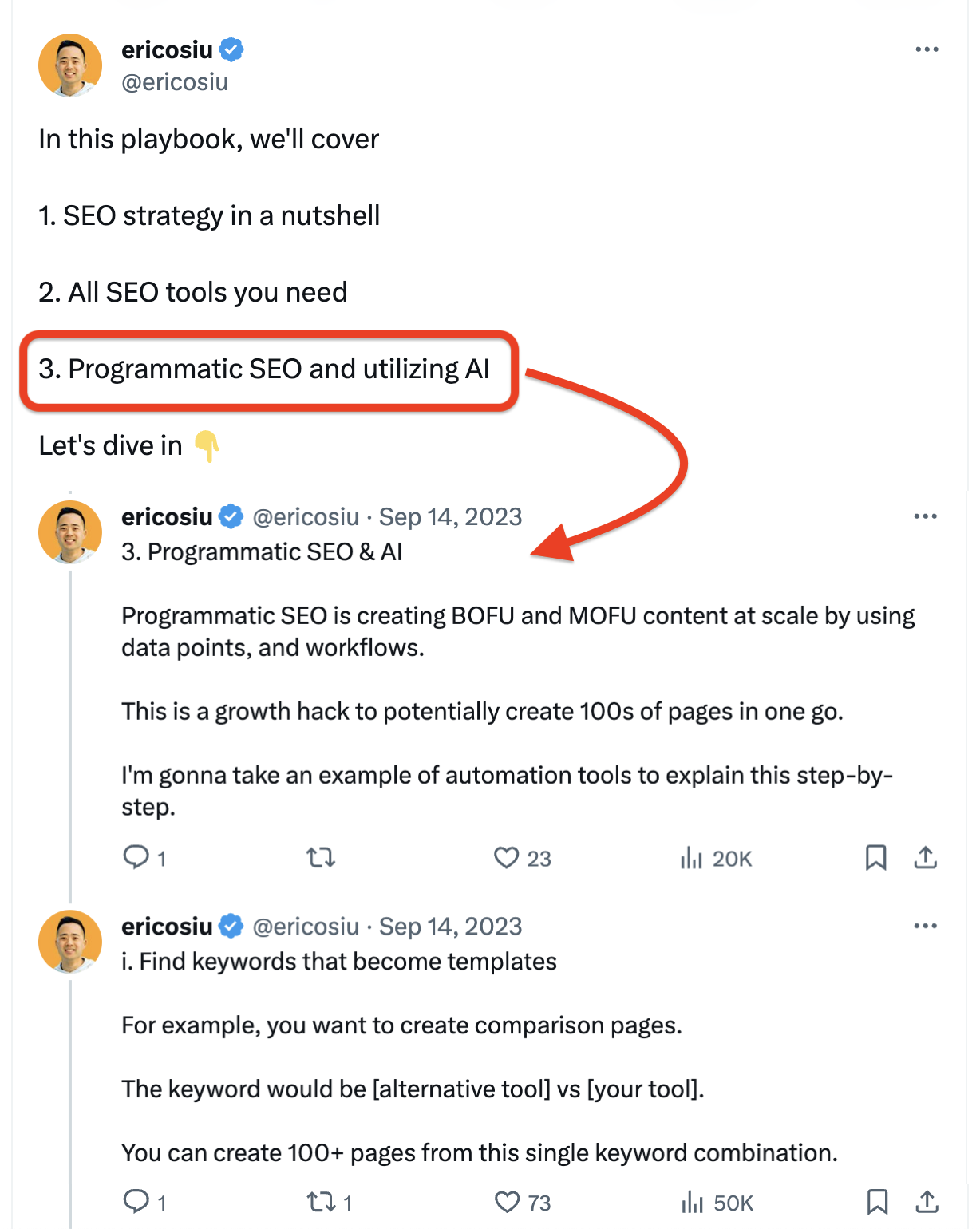If you aren’t already, you should take advantage of pSEO and AI-enhanced content while the iron is hot. This method of SEO enables you to generate thousands of top-quality web pages quickly, efficiently and cost-effectively, far surpassing traditional manual efforts.
That’s what we’ve been doing for our own brand as well as for our clients.
Single Grain, our U.S.-based digital agency that’s focused on being the most innovative marketing company in the world, drives hundreds of marketing qualified leads (MQLs) per month purely from our programmatic SEO efforts.
We created this playbook to show you how to launch pSEO using a real-life example from Single Grain, in which our team created 5,000 pages and grew our organic traffic by 2X in 6 months using this AI-enhanced approach.
Their expertise has helped Nextiva grow its brand and overall business
Struggling with the challenge of search engine unpredictability and need to drive more traffic to your site? Single Grain’s pSEO experts can help! Click the orange button.☝️
What Is Programmatic SEO (pSEO)?
Programmatic SEO (also known as pSEO) is the process of using automation, keyword targeting and data analysis to create and optimize a large number of high-ranking landing pages at scale to boost search engine rankings.
This process makes it easy for businesses to rank for hundreds of different searches related to their products or services by creating a huge list containing hundreds of long-tail keywords. They’ll often use different combinations of head terms (“running shoes,” “hotels in France,” etc.) and modifiers such as “best” (as in “best running shoes for beginners” or “best luxury hotels in France.)”.
For example, TripAdvisor ranks for permutations of “fun things to do in [city]”. If you think about all the cities in the world, that’s an estimated 50,000 pages to create. Now layer in more keywords such as “things to eat in [city]” and you’ll have another 50,000 pages. The list goes on and on and before you know it, you may have hundreds of thousands or millions of pages.
Single Grain founder Eric Siu believes that most companies are not nearly as aggressive as they could be with pSEO:
“If your site authority is strong and you have the ability to do programmatic SEO in your industry, you are doing yourself a disservice by not investing in pSEO.”
Yes, programmatic SEO works for exponentially scaling your traffic and conversions using AI, but there are drawbacks.
Here are a few to consider before you decide to scale out higher intent pages in the hundreds (or thousands):
1. Quality Control is an issue
If you’re letting… pic.twitter.com/PGXhIQvqVT
— ericosiu (@ericosiu) November 8, 2023
Examples of Programmatic SEO
Just so you fully understand what pSEO is, let’s take a look at a couple of popular examples.
TripAdvisor
Travel sites like TripAdvisor typically use pSEO as it helps them rank for specific keywords relating to thousands of different travel destinations which, as you can imagine, are almost never-ending.
Search for “top hotels in Pensacola,” for example, and you get this page as one of the top results:

Run a search for “top hotels in New York City,” and you’ll notice that these two pages are identically laid out:

That’s because both of these pages, and countless others that TripAdvisor uses to target “top hotels in [destination],” are all generated from the same template and populated with different content that’s relevant to each keyword.
Figuring that TripAdvisor started launching pSEO pages around 2015, take a look at the organic keywords they’ve rank for since then:
 And how much organic traffic they’ve gotten! 👉 206,875,139 visits per month:
And how much organic traffic they’ve gotten! 👉 206,875,139 visits per month:

Canva
Design app Canva is a great example of how Software as a Service (SaaS) can deploy programmatic pages to reach and attract users with different needs.
They use the same landing page layout for all search terms, including words like “builder” or “maker,” that are relevant to their service.
For instance, here’s “How to make a resume”:

And here we find “How to make a logo”:

The only difference is that each page features visual and written content that is tailored to each user’s (and each page’s) needs.
Once again, assuming that Canva started launching pSEO pages around 2015, take a look at the organic keywords and traffic they’ve rank for since then:

The Difference Between Traditional SEO & Programmatic SEO
Programmatic SEO and traditional SEO are essentially two different methods for achieving the same result:
- Increasing your visibility in search results
- Getting more traffic to your website
However, the way they achieve this is quite different:
- With regular SEO, you target one keyword at a time
- With pSEO, you do keyword research to find hundreds of related keywords and target them more or less at once.

This approach works best for low-competition keywords with commercial and transactional intent that typically have a low search volume, whereas regular SEO can work just as well for meeting those types of user intent as it can for informational and navigational intent.
I’ve seen websites shoot up to 700k+ visits/mo using pSEO…
Only to have it all evaporate in a span of days.
Programmatic SEO can be a boon for your traffic and conversions, but there are pitfalls that can completely tank your traffic.
Here are some key pSEO lessons:
1. Page…
— ericosiu (@ericosiu) November 14, 2023
Benefits & Challenges of pSEO for Businesses
Benefits of pSEO:
- Efficient: Using automation to create a lot of templated (or similar) pages is much more efficient and allows you to quickly publish your content. This results in faster response to market trends and user interests, which means that your content is always relevant and up-to-date.
- Increased Traffic: Although pSEO is about targeting long-tail keywords with low search volumes, you’ll also be targeting keywords with low keyword difficulty (KD), meaning you stand a very good chance at ranking high for them. Combine that with the sheer scale of pSEO, and you’ve got potentially thousands of high-ranking pages which, combined, can significantly increase your traffic.
- Increased Topical Authority: As Google E-E-A-T plays an ever-more prominent role in determining search results, anything you can do to bolster your site’s reputation as an authoritative source is only going to help you. By creating lots of web pages that cover every single aspect of your niche, you’re sending strong signals to Google about your topical authority.
- Increased Conversion Rates: Programmatic SEO generally goes after keywords that have a transactional or commercial investigation intent, which means that users are ready, or almost ready, to buy. By targeting these types of keywords at scale, you can draw in more users who are actively seeking information with the intent to make a purchase.
- Scalable: Implementing pSEO makes it easy to scale your web pages or other content and target a lot of keywords at once. This, of course, not only saves time, but also ensures consistency across your website, which enhances user experience and brand perception.
Challenges of pSEO:
- Keyword Cannibalization: Targeting every possible combination of head terms and modifiers does run the risk that you’ll end up with two or more pages targeting similar, if not identical, long-tail keywords. This is what’s known as keyword cannibalization, and it can have a major negative impact on your search results.
- Content Quality Control: On a related note, avoiding keyword cannibalization presents its own challenges as you need to ensure that every single page features unique content, a process which certainly gets difficult when you’re talking about hundreds or thousands of pages.
- Reduced Customization: The automated nature of pSEO can sometimes neglect the importance of individualized content, which can affect the user’s engagement with your site. So it’s important to make sure you are adding personalized and valuable elements to each page.
- Costs: Using the programmatic SEO techniques outlined below requires tools such as landing page creators and services that will build landing pages based on information stored in a database. These tools typically cost money, which may present a challenge for small businesses and those in larger companies who need budget approval from higher-ups.
- Technical Expertise Needed: Successfully executing programmatic SEO demands a certain level of programming proficiency. This involves creating dynamic page templates, handling APIs and effectively merging different data streams with your content management system.
Companies should take advantage of programmatic SEO and AI-enhanced content while the iron is hot.
Here’s what we’ve been doing for people:
1. Create a topical map of keywords that have high intent (MOFU and BOFU). For example, if you’re HubSpot, you might aim for keyword… pic.twitter.com/Z3nsE8zXl6
— ericosiu (@ericosiu) July 28, 2023
How to Generate Content Through Programmatic SEO
Our pSEO strategy involves these steps.
👉 NOTE: We actually built our own tool that generates keywords for us automatically. This allows us to tailor our unique SEO strategy, capture traffic that competitors miss, scale much faster and more efficiently, and continuously refine it based on changing search engine algorithms.
Want to learn more about our proprietary SEO Keyword Scout tool? One of Single Grain’s pSEO experts will be happy to talk to you.👇
Create a Vast List of Keywords
Here’s the step-by-step process of finding specific keywords based on your niche.
Step 1: Prepare a List of Head Terms
First thing: Get your head terms ready. We recommend that you have at least 20 head terms for optimum impact.
Let’s say, for example, that you own a pet website or blog and want to scale your organic traffic via programmatic SEO. These are some head terms you’ll want to target:
- Pet Food
- Pet Care
- Dog Training
- Pet Health
- Puppy Care
- Dog Breeds
Step 2: Add Keyword Modifiers
Next, add the keyword modifiers to to your head terms to make them niche-specific. This is our list of keyword modifiers for our head terms:

Now that you’ve added the modifiers to your head terms, it’s time to generate your full list of keyword ideas for creating city-specific landing pages.
Step 3: Enter Your Keywords in a Keyword Research Tool
Enter each of your main keyword with the modifiers into any keyword research tool. These are some good tools for this purpose:
- Semrush
- UberSuggest
- WordStream
- Ahrefs
- SE Ranking
I’ll be using SE Ranking. Here I’ve entered the keyword “best pet food for” into the tool:

And I get these ideas:


As you can see, the competition and search volume are both lower.
Step 4: Filter and Download Your List
Now you’ll want to review the list of keywords and choose those that make the most sense. After that, click on the “Export” button and download your filtered list of keywords:

Here are some keyword research tips to follow for pSEO keyword research:
- Find a good keyword that has a head term capable of generating at least 50-100 modifiers to support the creation of diverse landing pages for topical authority and domain boost.
- Pick keywords with less competition, as competitive keywords are hard to win.
- Identify keywords between 10-50 monthly searches; avoid extremes of high or low search volumes for optimal performance.
Semantic Keyword Integration
In programmatic SEO, semantic keyword integration is a crucial strategy for optimizing content and enhancing search engine visibility. It involves incorporating semantically related keywords and phrases that are contextually relevant to the main topic.
By understanding the user’s intent and including synonyms, variations and closely related terms, programmatic SEO helps in creating content that aligns more comprehensively with what users are searching for.
For instance, for the keyword “best pet food for labradors,” some of the possible semantic variations that you should use in your content are:
- Top-rated Labrador dog food
- High-quality pet nutrition for Labradors
- Labrador-specific dog meals
- Best diet for Labrador Retrievers
- Premium pet food tailored for Labradors
- Nutrient-rich Labrador feeding options
- Labrador-friendly pet nutrition
- Labrador-approved dog food brands
- Specialized meals for Labrador health
- Optimal feeding for Labrador Retrievers
Semantic SEO improves the search engine’s understanding of the content and caters to a broader range of user queries, ultimately contributing to a more robust and effective programmatic SEO strategy.
Next Steps in Our Programmatic SEO Strategy
After creating our huge list of keywords for our pSEO strategy, these are the next steps we take:
- Design a Template for Your Landing Pages for Different Keyword Types. This allows for consistency and efficiency in presenting information tailored to various keyword groups. By categorizing keywords into types (e.g., product-specific, informational, geographic), you can design templates that best match the user intent associated with each category, making the pages more effective at converting visitors. Do this for every new page you’ve decided to create. This’ll make your job easy and help you scale content.
- Create a Strong Internal Linking Structure. This helps search engines locate the vast number of new pages. To ensure good interlinking, we have one page that has a link to all the pSEO pages and this page is added to the footer on every other page. On the individual pSEO page level, we have 10 random links to other related pSEO pages.
- Delete and Update Content Where Necessary. We have built a proprietary AI content auditor tool that automatically, at scale, evaluates the quality of the pages using LLM and then flags lower quality and/or duplicate/too similar content.
- Layer in Contextual Calls to Action Using AI. Integrating AI to dynamically generate contextual CTAs on your pages can significantly enhance conversion rates because the relevant CTA matches the user’s current needs and interests. For example, a page targeting keywords around “buying guide” could display CTAs for related product comparisons or purchasing options.
- Continually Update the UX of These Pages. Regular UX updates help retain visitors, reduce bounce rates and increase the likelihood of conversions. This could involve making design and navigational improvements, optimizing page speed and basically just making sure your content is easy to interact with.
Final Step: Repeat!
After implementing the other steps outlined here, it’s essential to cycle back and revisit each step periodically (as with any campaign, obviously). This iterative approach ensures that your programmatic SEO efforts remain effective and up-to-date.
Constantly re-evaluating your landing page templates, internal linking structure, content quality, contextual CTAs, and user experience allows for continuous improvement and adaptation to changing search engine algorithms and user behaviors.
Do this and your pSEO efforts will always be moving forward, maximizing your site’s visibility and conversion potential.
The Results We’ve Seen from Our pSEO Efforts
Here’s how the Single Grain site sits in terms of impressions and clicks since we started.
We launched our programmatic SEO strategy in June 2023 with zero impressions/clicks related to pSEO and as of today we’ve gotten 9.18M impressions and 12.1K clicks out of this pSEO initiative for one category.

Our pSEO pages initiative generated 16,091 backlinks based on latest data:

Last Word on Our pSEO Strategy
And that’s the short version of our pSEO strategy!
It is a lot to set up to get started with pSEO, to be sure, but it is definitely worth it.
And, to be absolutely honest, it takes a lot of maintenance. You need to be consistently evaluating which pages are working, updating pages that show opportunity, and creating new lists for creation.
The good news is: Single Grain can help with all of this! Whether you want help with a one-time set up and/or ongoing maintenance, we can take all this work off your plate.
Ready to drive a significant increase in organic traffic to your website? Single Grain’s pSEO experts can help!👇
Programmatic SEO (pSEO) FAQs
-
What is programmatic SEO?
Programmatic SEO refers to the process of using automated systems to create and optimize a large number of web pages. The goal is to target a wide range of long-tail keywords, particularly in industries where the volume of potential search queries is vast and varied.
This approach allows for scaling SEO efforts more efficiently than manual page creation and optimization would allow. By leveraging data and templates, businesses can generate pages that are tailored to specific queries, improving visibility across search engines and driving targeted traffic more effectively.
-
How do I find keywords for programmatic SEO?
Longer answer: Scroll up and read this blog post!
Shorter answer: Here is a quick run-down of to find keywords for programmatic SEO:
- Use Keyword Research Tools: Tools like Google Keyword Planner, Ahrefs, Semrush, and Moz Keyword Explorer can help you discover keywords related to your core topics. These tools provide insights into search volume, competition, and related terms.
- Analyze Search Intent: Understand the intent behind the searches related to your business. This involves categorizing keywords according to whether users are looking for information, to make a purchase, or to find a particular website.
- Competitor Analysis: Look at the keywords your competitors are targeting. Tools like Ahrefs and Semrush can show you the keywords for which your competitors rank, giving you insights into potential areas of opportunity.
- Long-Tail Keyword Focus: Focus on long-tail keywords, which are longer and more specific keyword phrases. They often have lower search volume but can be less competitive and more targeted towards specific queries.
- Leverage Question Keywords: Use tools like Answer the Public to find question-based keywords. People often type questions into search engines, so targeting these can be a good strategy.
-
How to do programmatic SEO in WordPress?
Doing programmatic SEO in WordPress involves creating dynamic pages that are optimized for search engines using automated methods. Here is a brief look at the steps to implement pSEO on a WordPress site:
- Custom Post Types and Taxonomies: Use custom post types and taxonomies to organize your content programmatically. Plugins like Custom Post Type UI can help with this.
- Dynamic Templates: Develop dynamic templates that can automatically adjust content based on the specifics of the keyword or category they’re targeting. This may involve custom coding or using page builder plugins that allow for conditional logic.
- SEO Plugins: Use SEO plugins like Yoast SEO or Rank Math. These plugins can help automate many SEO tasks, including generating XML sitemaps, optimizing meta tags, and more, based on the content of your pages.
- Automated Content Creation: Use plugins or custom scripts to automatically generate content for your pages. This should be done carefully to ensure content quality and relevance.
- Structured Data: Implement structured data (Schema.org) to help search engines understand the content of your pages better. Plugins like Schema Pro can automate this process for you.
-
Is SEO programmatic advertising?
No, SEO (Search Engine Optimization) and programmatic advertising are different digital marketing strategies.
SEO focuses on optimizing websites to rank higher in organic search results for specific keywords. It involves on-page optimization (like content creation and keyword optimization) and off-page optimization (like link building and social media engagement) to improve search rankings and drive free traffic from search engines.
Programmatic advertising, on the other hand, refers to the automated buying and selling of online advertising space. It uses software and algorithms to purchase display space in real time, targeting specific audiences based on data such as demographics, interests, behavior, and more. While SEO aims to improve organic search visibility, programmatic advertising focuses on paid ad placements across the web.
Both strategies can be complementary parts of a comprehensive digital marketing plan, but they operate differently and serve different purposes in attracting and engaging audiences online.



